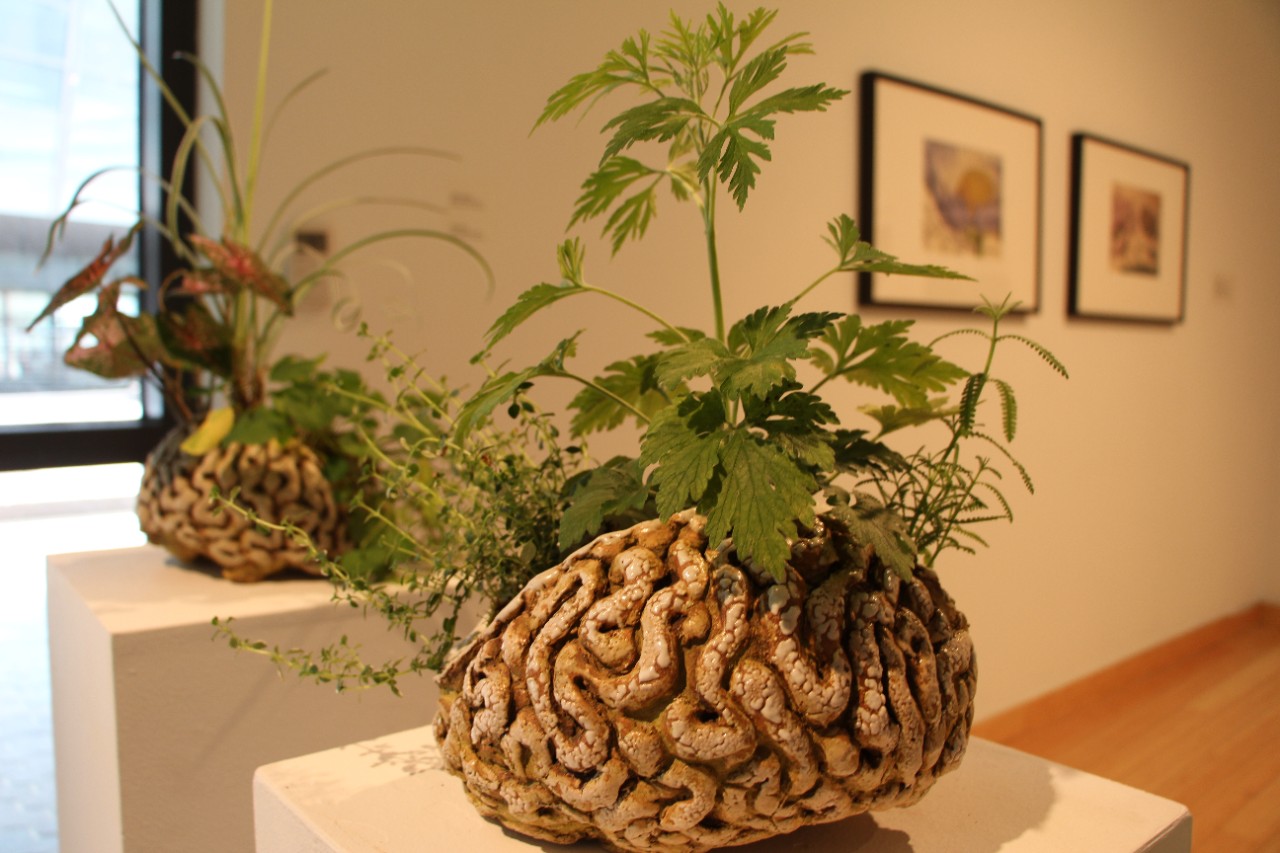
UC's Meyers Gallery transformed into interactive greenhouse
The new exhibit, called Phytotherapies: Plants that Heal, is on display now
By Michelle Flanagan
The University of Cincinnati Meyers Gallery has a fresh new exhibit. “Phytotherapies: Plants that Heal” opened in conjunction with the 2019 Society for Economic Botany conference, an international gathering held on UC's Uptown Campus, in early June.
The exhibit is designed to create a restful space for UC students, faculty, staff and other community members to connect – or reconnect – with plants. This isn’t achieved simply by sitting on a bench in a greenhouse. Instead, the exhibit includes a variety of works of sculpture, photography, videography, printmaking, and painting, some of which do include live plants.
Several pieces, such as Sharon Bladholm’s “Green Hearts” and “bRAINforest”, point to mind-body connections and the positive impact that plants play in health.
“The idea for the exhibit emerged from an interest in bringing my friend Michael Galinsky’s beautiful series of photographs to campus during the Society for Economic Botany meetings," said Susan Allen, assistant professor of anthropology in UC's McMicken College of Arts and Sciences and director of the exhibit.
“Because they feature plants, but are the product of his meditative practice of observation in the meadow near his North Carolina home as a way to heal trauma, I began thinking about the ways that plants heal at many different scales of experience beyond their pharmacological and nutritional effects. Simply being around plants has been shown to produce a calming effect,” she said.
Aaron Cowan, director of the Meyers Gallery, leans into the idea of the gallery as a student-centered space. To further this mission, only a small amount of text is included to prevent visitors from being overwhelmed with technical information. The gallery has a clean design layout. And there’s a full wall with an award-winning forest bathing video (Shinrin-Yoku, by Mark Knight), complete with sounds of different forests.

Digital nature prints by Arturo Vazquez, 2017. Photo: Beth Vleaminck.
This topic complements Allen’s professional work.
“As an anthropologist, I’ve been trained to consider the many ways that plants are significant for people, which goes far beyond their use as foods and medicines,” she said. “More than understanding what plant is useful for what purpose, learning about the factors that shape the way that people perceive plants and how they interact with them is what really interests me.”

Photographs on canvas: The Meadow. Merritt's Field (series), by Michael Galinsky, 2017. Photo: Beth Vleaminck
She hopes that the gallery, along with the SEB conference, will encourage student attendees and new botanists to feel at ease and even provide an opening for conversation in a relaxing, inviting space.
UC anthropology professor Alan Sullivan is confident that the exhibit will do exactly that.
“Rarely has UC hosted an international conference that celebrates its subject matter with a public gallery project that appeals to everyone,” he said. “Dr. Allen’s attention to the intricacies of our dependence on plants illustrates the intimate connection between science and art and celebrates how plants vitalize the human spirit.”
One of Allen's primary goals for this exhibit was to help guard against “plant blindness”, an ever-growing phenomenon due to economic development and environmental depletion. Plant blindness is the inability to recognize or notice plants, and happens in many urban areas where opportunities to interact with plants are limited.

Pitcher Plants, Sharon Bladholm, ceramics, 2015 and 2019. Photo: Beth Vleaminck
Why does that matter?
“Because of the important role that plants play in safeguarding biodiversity, moderating climate change, and providing sustenance for people,” Allen says, “plant blindness poses a real threat to our ability to address pressing environmental problems such as global warming and food security.”
For those who already know their plants, several greens with known culinary, medicinal, and spiritual significance are included, along with air-filtering and aesthetically pleasing varieties. In selecting live plants for Bladholm's ceramic planter, Allen sought to include useful plants from several regions. For example, Cinnamon Vine is native to China and widely used as a food and a treatment for ailments; Mayan Mint, native to Mexico, was historically used for respiratory ailments, and its edible flowers are now sold in markets and used as a sweetener; and Society Garlic, native to southern Africa, was chosen for planting in one of Bladholm's ceramic hearts to allude to the relationship between garlic and heart health, as well as for its delicate lavender blooms.
Meyers Gallery
The exhibit is free and open to the public from 10 a.m. to 5 p.m. Sundays through Thursdays through Aug. 16 at the Meyers Gallery on UC's Uptown Campus, Joseph A. Steger Student Life Center, 2624 Clifton Ave.
All of the plants were donated by Al Funke of Funke’s Greenhouse. The event is sponsored by UC DAAP Galleries, the UC Department of Anthropology, Funke’s Greenhouse, the Lloyd Library, and Sharecare | Windows.
Featured image at top: bRAINforest, Sharon Bladholm, 2018, ceramic with planting by Susan Allen. Photo: Beth Vleaminck
Related Stories
UC's art collection on display at the Contemporary Arts Center
January 5, 2026
University of Cincinnati leaders joined WVXU's Cincinnati Edition to talk about the university’s 200-year-old art collection, a new exhibition at the Contemporary Arts Center and the release of a companion book exploring the collection’s role in education and public engagement.
UC biochemistry student explores world of taste
January 5, 2026
A University of Cincinnati biochemistry student changed her career trajectory after being inspired by internships with a European Fortune 500 company.
Fusion reactors may be key to uncovering dark matter
December 22, 2025
Yahoo! News highlights a new study by University of Cincinnati physicist Jure Zupan that explains how fusion reactors might create subatomic particles associated with dark matter.
